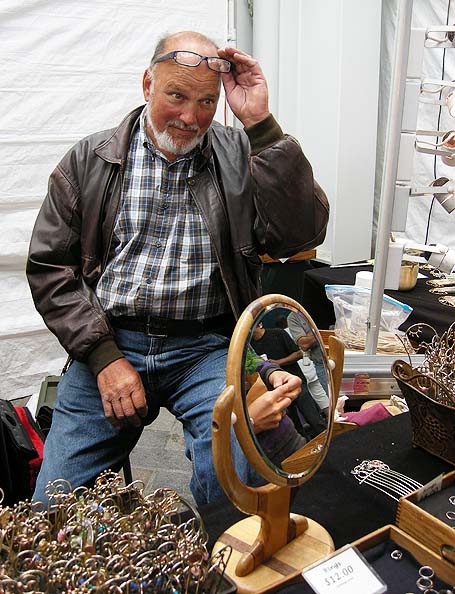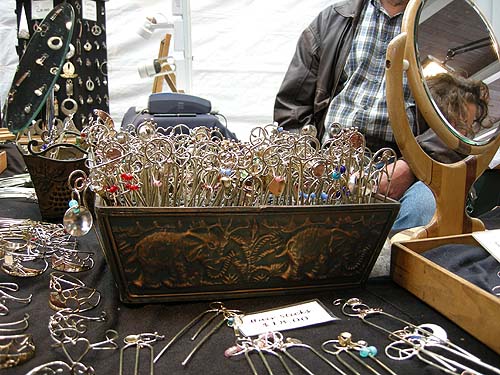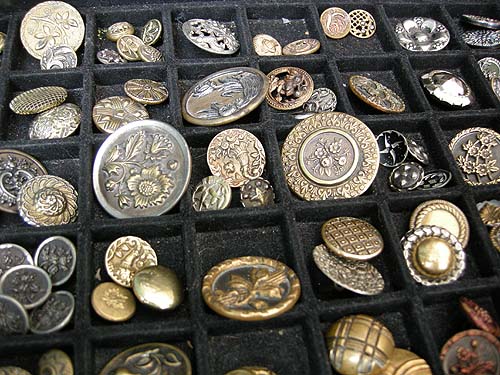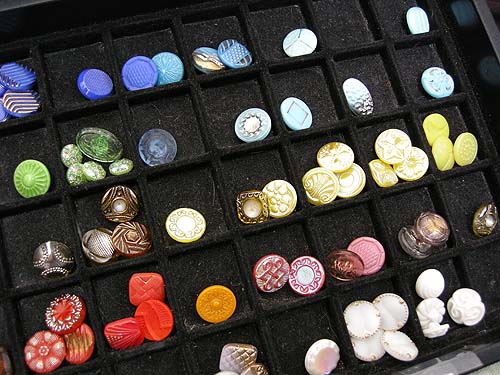 The Saturday Market is an icon of the craft movement and a Portland institution. But even the market’s dedicated 400-plus vendors never expected the boost a new location would bring for business.
The Saturday Market is an icon of the craft movement and a Portland institution. But even the market’s dedicated 400-plus vendors never expected the boost a new location would bring for business.
BY EMMA HALL
 |
 |
Gary Spehar sells his handmade jewelry, including earrings, rings, and hair sticks, at the Saturday Market every weekend. |
On any given Saturday or Sunday from March to Christmas Eve, Portland’s waterfront is bustling with tourists, soccer moms and couples sipping lattes all mingling to peruse handmade art from a whopping 258 rotating local artists.
Now in its 37th season, the Portland Saturday Market is the largest arts and crafts market in continuous operation in the United States, with an estimated $8 million in gross sales. It has become an iconic symbol of Portland’s art scene, with tourists visiting, magazine clipping about the market in hand, to see what all the hoopla is about.
Last August, the market officially moved into its new location at Tom McCall Waterfront Park, allowing for more vendors, larger walkways and all-around higher exposure for the market. The nonprofit membership market underwent a lengthy planning process in conjunction with the Portland Development Commission that considered four or five sites — but really, anywhere would have been better than the dark old location under the Burnside Bridge. The vendors knew the waterfront location would bring a fresh change to the market, but none could fathom just how large the change would be. Some vendors are reporting increases in business of up to 25% to 30%.
The Oregon craft movement started about 40 years ago, and Gary and Marti Spehar were right there on the forefront. They began selling their handmade soft metal jewelry at the Eugene Saturday Market, which started in 1970, right before the Portland Saturday Market. They participated in the very first year of the market in Portland, although they weren’t officially on the books that season. It’s safe to say the market, which now balances a rotating list of over 400 vendors vying for 258 spots, is much more organized in its 37th year.
The Spehars’ daughter, Sarin, fondly remembers running around the market as a 5-year-old, and has grown up to be a recently elected Saturday Market board member. From making budget decisions to figuring out the bathroom situation (hopefully soon there will be more than portable toilets available to marketgoers), the board makes sure the market sticks to its original ideals of being a market for the members, by the members.
Sarin Spehar definitely noticed a change since the market moved locations. The Spehars estimate the new location has increased their sales by more 25%. Reid Decker, promotions coordinator for the market, stresses the fact that the vendors aren’t just craft hobbyists, creating handmade art is their full-time job. They create art Monday through Friday, and sell it face-to-face with the customers on Saturday and Sunday. A 25% increase in sales is a huge change for these micro-businesses.
 |
 |
Chelsey Clark collects vintage buttons at estate sales and from customers for her upcycled jewelry. |
Another change that the new location has brought is a higher level income bracket in the clientele. One vendor described the change in terms of the pets that the dog-friendly market experienced —from the classic family golden retriever to an influx of chihuahuas and other “purse dogs.”
Executive director Paul Verhoeven attributes an uptick in customers to the down economy. “Because of the recession, people tend to stay in town,” Verhoeven said. “In the new location, more locals are taking another look [at the market] and putting it further up on their radar.”
The change in clientele also includes a lot more national and international tourists. A lot of publicity about the quest to move locations and reviews in national magazines, as well as run-off from nearby festivals on the waterfront brought about this change. “[In years past], the Rose Festival meant slower business, but this year it actually brought more business,” said Sarin Spehar.
S.J. Mari vendor Chelsey Clark is in her first year of selling her wares —upcycled vintage buttons lovingly wire-wrapped into rings while the customer waits —at the market. She was a long-term customer at the market for years before, and so experienced the old and new locations on opposite sides of the table. “The new location is much more friendly to large amounts of people and families and the layout appears cleaner and feels less stuffed,” Clark said.
Even though the new location has brought changes for the better for Oregon artists, the charm in the market still lies in its history. “I love being a part of the market because it is a piece of Portland history,” Clark said. “I get to sit next to vendors who have been selling here for 30 years.”
Emma Hall is web editor for Oregon Business.


